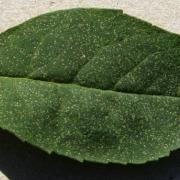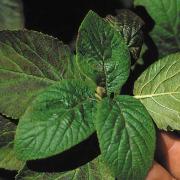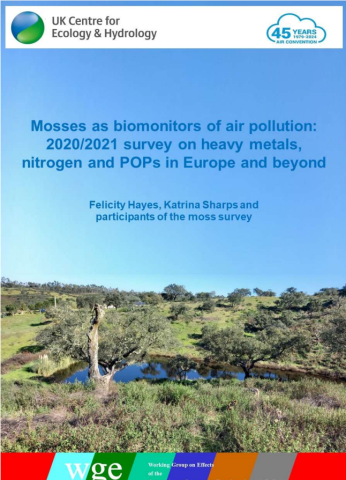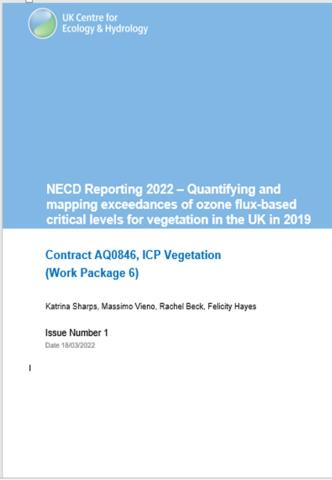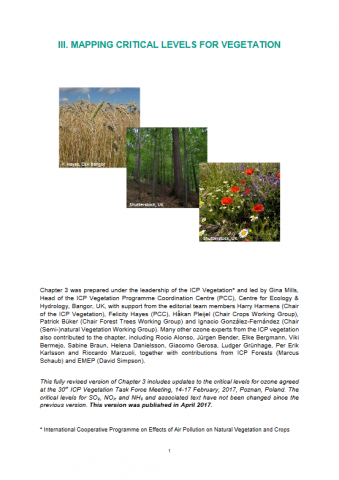Ozone impacts on vegetation
Ground-level ozone is a secondary air pollutant and a greenhouse gas, contributing to warming of the globe. It is produced from reactions between the primary air pollutants nitrogen oxides (sources: transport and industry) and volatile organic compounds (sources: petrol, natural gas, paints, certain tree species) during warm and sunny weather. Ozone concentrations are particularly high in rural areas downwind of cities. Ozone enters vegetation via the small pores in the leaves, causing visible injury to develop on the leaves of sensitive plant species. Typically, injury is present between the veins on the older leaves, with small bronze, brown, or yellow flecks appearing on the upper surface (see photos below). In severe cases, the flecks can join to form large lesions covering most of the leaf surface. Ozone will cause leaves to turn yellow and die-off earlier than normal in sensitive species. Ozone-sensitive plant species include crops such as wheat, soybean, beans and pulses; trees such as beech, birch, Norway spruce, poplar, oak; wildflowers such as the harebell, meadow buttercup and cowslip; and grasses such as Dactylis glomerata, Briza media and Phleum bertolonii.
Ozone injury on white clover, ash, wayfaring tree and hornbeam respectively.
The role of the ICP Vegetation with respect to ozone pollution is:
- Collate evidence of ozone impacts on vegetation (from field surveys, ozone exposure and filtration experiments, small-scale studies with chemical protectants);
- Develop ozone dose-response/flux-effect relationship to establish safe thresholds (critical levels) for modelling and mapping the risk of ozone impacts on vegetation;
- Model and map impacts of ozone on vegetation from local to global scale, applying agreed risk assessment methodologies and current and future air pollution emissions and climate change scenarios;
- Study interactive impacts between ozone pollution and climate change, and interactive impacts between ozone and other air pollutants such as nitrogen on vegetation, including consequences for biodiversity.
Ozone impact on food security
The participants of the ICP Vegetation study the effects of ozone on crops using a variety of ozone exposure methods (e.g. closed chambers, open-top chambers, solardomes, field release systems).
(a) & (b) Solardomes and field release system at CEH Bangor, North Wales; (c) Open Top Chambers, Curno, Italy.
In 2011, the ICP Vegetation published a report highlighting the potential impact of ozone pollution on food security. The report provides detailed information on how ozone may reduce the availability of food, presents an analysis showing varying sensitivity of different crop species to ozone and carries out the first flux-based assessment of ozone impacts on wheat yield in Europe.
Ozone injury on wheat, finger millet, common bean (var. Pinto) and rice respectively.
In 2018, two papers were published in Global Change Biology on global ozone flux-based assessments reporting on the impacts of ozone on wheat, and maize, soybean and rice yield, led by Professor Gina Mills (former Head of the ICP Vegetation Programme Coordination Centre). Total wheat production losses due to ozone for developing countries receiving Official Development Assistance funding (ODA) were 50% higher than those in developed countries. Results also showed that efforts to improve wheat yield by increasing irrigation may actually exacerbate the effect of ozone in some areas of the world (e.g. USA). In the second paper, the impacts of ozone pollution on crops were put into context with other crop stressors, including heat stress, aridity, soil nutrient availability and pests and diseases. Crops varied in sensitivity to ozone, with global yield losses (average for 2010-2012) greatest for soybean (12.4%), then wheat (7.1%), rice (6.1%) and maize (4.4%). The impact of ozone on yield was found to be within the range of concern for other crop stressors. For example, the ozone stress scores for wheat, maize and rice were mainly in the same range as global impacts of heat stress and aridity.
There is a need to include ozone as a stress factor in the development of new, high yielding crop varieties. Crop management options (e.g. smart irrigation) should be further investigated to assess their potential in mitigating adverse impacts of ozone on crop yield.
Recording evidence of ozone damage on leaves
Collection of field-based evidence on the occurence of ozone-induced leaf injury enables the verification of predictions from experiments and models, and helps to demonstrate the impact of current ambient ozone levels.
Since 1998, ICP Vegetation participants have been conducting biomonitoring experiments with ozone-sensitive plant species such as white clover and French beans. In 2007, the ICP Vegetation published an Evidence Report detailing widespread ozone damage to vegetation in Europe during the period 1990-2006. Over 500 incidences of visible ozone injury were recorded on crops, grassland species and shrubs growing in the field under ambient conditions in 17 countries across Europe. Compared with ozone concentration risk maps, risk maps based on ozone stomatal flux are better at predicting the occurrence of ozone damage on vegetation. Hence, the flux-based methodology (applying the DO3SE model) and critical levels are recommended for assessing the risk of ozone impacts on vegetation for policy applications.
a) b)
a) EMEP modelled mean ozone concentrations and ((b) generic-flux based metric (right) for crops for 1995 to 2004, superimposed with the location of all sites where an effect of ozone has been detected during those ten years. Map data source: EMEP/MSC-West.
In order to build upon the data gathered for the 2007 evidence report, in 2014, the ICP Vegetation developed a smart-phone App for recording incidences of ozone-induced injury on vegetation. The aim is to create a database of injury records from around the world, adding to the growing list of ozone-sensitive plant species. A second follow up evidence brochure was published in 2016, which included a collation of field evidence of impacts of ozone on vegetation for the period 2007-2015. Data included biomonitoring records from ICP Vegetation participants, data from published literature and records received from App users.
For details of ozone impacts and visible injury symptoms on tree species, see:
Ozone injury in European forest species
Global map of collated ozone injury records using biomonitoring experiments, the ozone-injury smart phone App and peer-reviewed scientific literature for the period 2007-2015.
With the recent development of the ICP Vegetation-Asia network, our aim is to gather further biomonitoring data on the impacts of ozone on vegetation from Asian countries. Ground-level ozone concentrations in (South-)East Asia are amongst the highest in the world. An 'SOS' (Sensitive Ozone Species) network of gardens will be established across Asia to provide evidence of the geographical extent of the damaging effects of ozone pollution on vegetation. For further information on how to set up a garden, see the ICP Vegetation 'SOS' monitoring protocol document.
There are also plans to extend the network to Africa, please contact Felicity Hayes (fhay@ceh.ac.uk) if you are interested in taking part.
Ozone critical levels for vegetation
During the 1980s, the Convention on Long-range Transboundary Air Pollution (LRTAP Convention) adopted the critical loads/critical levels approach to defining sensitivity of receptors to pollutants. Much progress has been made since then in establishing critical levels of ozone for vegetation, above which adverse effects could be expected. Several Convention workshops have been held in which the critical levels of ozone for crops, (semi-)natural vegetation and forest trees were established. Two main types of critical levels have been developed:
- Concentration-based critical levels that are based on the concentration of ozone in the air immediately above the plant.
- Flux-based critical levels that are based on the amount of ozone entering the leaves of plants. Ozone fluxes are calculated using knowledge of how climate, soil factors and plant factors influence the opening and closing of the stomatal pores on the leaf surface.
In addition, methods have been developed for mapping the risk of damage to a generic crop and two generic tree species using a simplified flux model that can be applied within integrated assessment modelling. Ozone critical levels, their scientific basis and generic flux -based risk assessments are described in detail in Chapter 3 of the LRTAP Convention Modelling and Mapping Manual. This manual was substantially revised in 2017 and has been updated with the decisions made at the most recent ozone critical levels workshop in Madrid ('UNECE Ozone Critical Levels Workshop, Madrid, Spain,' 7-8 Nov 2016) and discussions at the 30th ICP Vegetation Task Force Meeting (Poznan, Poland, 14-17 Feb 2017).
Ozone impacts on (semi-)natural vegetation
While the impact of ozone on crops and trees has been extensively studied, less is known about the effect on (semi-)natural vegetation, due to the number of species and complexity of communities in natural ecosytems. In diverse plant communities, differences in ozone sensitivity between species (e.g. due to leaf diffusive properties or cellular detoxification capacity) can lead to long-term changes in species eveness or richness. Grassland and wetland habitats are important for the conservation of biodiversity, and in some habitats, for example temperate perennial grasslands, species are exposed to ozone over long growing seasons.
Previous work by ICP Vegetation participants has included studying ozone effects on:
Early die-back of leaves (Dawnay and Mills, 2008)
Community composition (Hayes et al., 2010)
Timing of flowering and flower number (Hayes et al., 2012)
Biomass (long-term O3 exposure with increased N and controlling for climate) (Volk et al., 2014)
Peatland plant growth and carbon gas exchange (Williamson et al., 2016)
N-fixation in legumes (Hewitt et al., 2016)
Recent work includes investigations of the impact on ozone on species in the Mediterranean Dehesa, (open oak forest with annual pasture understory), which has a high species richness. Due to weather conditions in the region, Mediterranean vegetation is exposed to high levels of ozone (relative to other parts of Europe) and levels are predicted to rise in the future due to an increased frequency in symmer droughts and higher temperatures. Studies include determining the effects of nitrogen on ozone critical levels (Calevete-Sogo et al., 2017) and testing how plants growing in their natural environment, under inter-specific competition, respond to ozone (Gonzalez-Fernandez et al., 2017).
For recent flux-effect relationships for selected (semi-)natural species, and flux model parameterisations, see the Modelling and Mapping Manual and associated Scientific Background Document A.
Summary
- Ground-level ozone is a secondary air pollutant and has adverse impacts on sensitive vegetation;
- There is evidence of widespread ozone damage to vegetation in Europe, evidence is emerging for Asia where ozone pollution is high;
- Current ambient ozone reduces yield of sensitive staple crop species such as maize, rice, soybean and wheat between 4 and 12% globally;
- Twenty one flux-based ozone critical levels are available for modelling and mapping the risk of ozone impact on vegetation;
- Evidence suggests that ozone and nitrogen pollution can have both synergistic and antagonistic effects on plant species and ecosystems.
